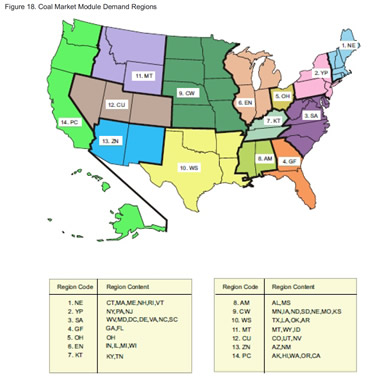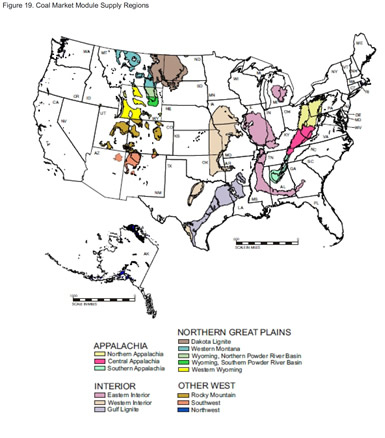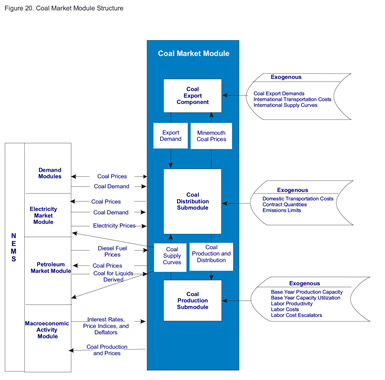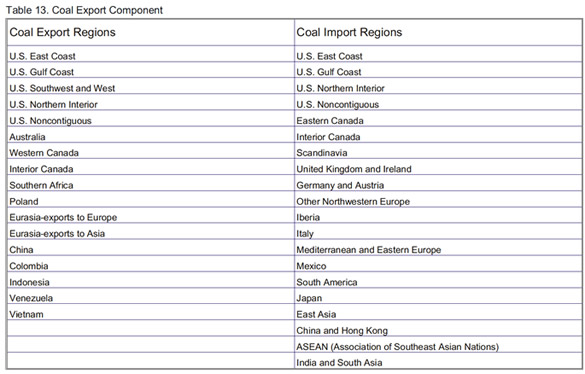|
Home >
Forecasts & Analyses > The National Energy Modeling System: An Overview > Coal Market Module
|
The National Energy Modeling System: An Overview
|
Full Printer-Friendly Version |
|
Find on this page:
Coal Market Module
|
|
| Coal Market Module |
|
|
The coal market module (CMM) represents the mining, transportation, and
pricing of coal, subject to end-use demand. Coal supplies are differentiated
by thermal grade, sulfur content, and mining method (underground and surface).
CMM also determines the minimum cost pattern of coal supply to meet exogenously
defined U.S. coal export demands as a part of the world coal market. Coal
distribution, from supply region to demand region, is projected on a cost-minimizing
basis. The domestic production and distribution of coal is projected for
14 demand regions and 14 supply regions (Figures 18 and 19).
The CMM components are solved simultaneously. The sequence of solution
among components can be summarized as follows. Coal supply curves are produced
by the coal production submodule and input to the coal distribution submodule.
Given the coal supply curves, distribution costs, and coal demands, the
coal distribution submodule projects delivered coal prices. The module
is iterated to convergence with respect to equilibrium prices to all demand
sectors. The structure of the CMM is shown in Figure 20. |
 |
|
Click for a larger version |
| Coal Production Submodule |
|
back to top |
This submodule produces annual coal supply curves, relating annual production
to minemouth prices. The supply curves are constructed from an econometric
analysis of prices as a function of productive capacity, capacity utilization,
productivity, and various factor input costs. A separate supply curve is
provided for surface and underground mining for all significant production
by coal thermal grade (metallurgical, bituminous, subbituminous and lignite),
and sulfur level in each supply region. Each supply curve is assigned a
unique heat, sulfur, and mercury content, and carbon dioxide emissions
factor. Constructing curves for the coal types available in each region
yields a total of 40 curves that are used as inputs to the coal distribution
submodule. Supply curves are updated for each year in the projection period.
Coal supply curves are shared with both the EMM and the PMM. For detailed
assumptions, please see the Assumptions to the Annual Energy Outlook updated
each year with the release of the AEO.
|
|
|
Click for a larger version |
| Coal Distribution Submodule: Domestic Component |
|
back to top |
The coal distribution submodule is a linear program that determines the
least-cost supplies of coal for a given set of coal demands by demand region
and sector, accounting for transportation costs from the different supply
curves, heat and sulfur content, and existing coal supply contracts. Existing
supply contracts between coal producers and electricity generators are
incorporated in the model as minimum flows for supply curves to coal demand
regions. Depending on the specific scenario, coal distribution may also
be affected by any restrictions on sulfur dioxide, mercury, or carbon dioxide
emissions.
Coal transportation costs are simulated using interregional coal transportation
costs derived by subtracting reported minemouth costs for each supply curve
from reported delivered costs for each demand type in each demand region.
For the electricity sector, higher transportation costs are assumed for
market expansion in certain supply and demand region combinations. Transportation
rates are modified over time using econometrically based multipliers which
considers the impact of changing productivity and equipment costs. When
diesel fuel prices are sufficiently high, a fuel surcharge is also added
to the transportation costs.
|
|
|
Click for a larger version |
| Coal Distribution Submodule: International Component |
|
back to top |
The international component of the coal distribution submodule projects
quantities of coal imported and exported from the United States. The quantities
are determined within a world trade context, based on assumed characteristics
of foreign coal supply and demand. The component disaggregates coal into
17 export regions and 20 import regions, as shown in Table 13 below. The supply
and demand components of world coal trade are segmented into two separate
markets: 1) coking coal, which is used for the production of coke for the
steelmaking process; and 2) steam coal, which is primarily consumed in
the electricity and industrial sectors.
The international component is solved as part of the linear program that
optimizes U.S. coal supply. It determines world coal trade distribution
by minimizing overall costs for coal, subject to coal supply prices in
the United
States and other coal exporting regions plus transportation costs. The
component also incorporates supply diversity constraints that reflect the
observed tendency of coal-importing countries to avoid excessive dependence
upon one source of supply, even at a somewhat higher cost.
| |
|
|
|
| |
|
|
Preface and Contacts
Appendix |
|
|
|
|





